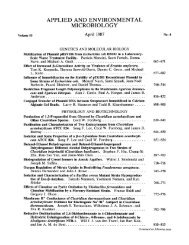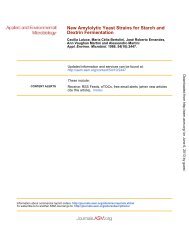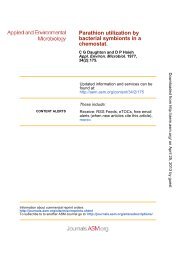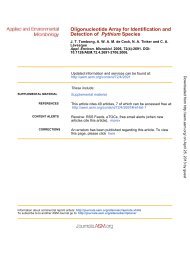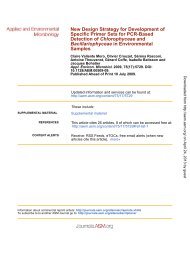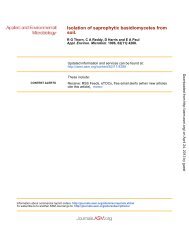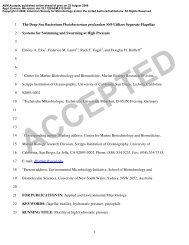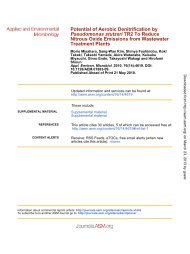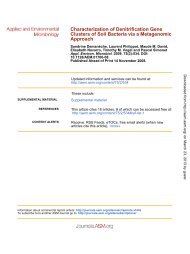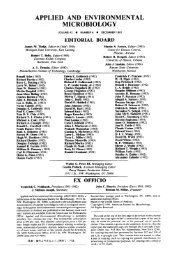SulE, a Sulfonylurea Herbicide De-esterification Esterase from ...
SulE, a Sulfonylurea Herbicide De-esterification Esterase from ...
SulE, a Sulfonylurea Herbicide De-esterification Esterase from ...
You also want an ePaper? Increase the reach of your titles
YUMPU automatically turns print PDFs into web optimized ePapers that Google loves.
AEM Accepts, published online ahead of print on 13 January 2012<br />
Appl. Environ. Microbiol. doi:10.1128/AEM.07440-11<br />
Copyright © 2012, American Society for Microbiology. All Rights Reserved.<br />
1<br />
2<br />
3<br />
4<br />
5<br />
6<br />
7<br />
8<br />
9<br />
10<br />
11<br />
12<br />
13<br />
14<br />
<strong>SulE</strong>, a <strong>Sulfonylurea</strong> <strong>Herbicide</strong> <strong>De</strong>-<strong>esterification</strong> <strong>Esterase</strong><br />
<strong>from</strong> Hansschlegelia zhihuaiae S113<br />
Bao-Jian Hang ** , Qing Hong ** , Xiang-Ting Xie, Xing Huang, Cheng-Hong Wang, Jian<br />
He * and Shun-Peng Li<br />
Key Laboratory of Agricultural Environmental Microbiology, Ministry of Agriculture,<br />
College of Life Sciences, Nanjing Agricultural University, Nanjing, Jiangsu 210095,<br />
China.<br />
* Author for correspondence<br />
E-mail address: hejian@njau.edu.cn<br />
**Both authors contributed equally to this work<br />
Tel: +86-25-84396685<br />
Fax: +86-25-84396314<br />
1
15<br />
16<br />
17<br />
18<br />
19<br />
20<br />
21<br />
22<br />
23<br />
24<br />
25<br />
26<br />
27<br />
28<br />
29<br />
30<br />
31<br />
32<br />
33<br />
34<br />
35<br />
ABSTRACT<br />
<strong>De</strong>-<strong>esterification</strong> is an important degradation or detoxification mechanism of<br />
sulfonylurea herbicide in microbes and plants. However, the biochemical and<br />
molecular mechanisms of the sulfonylurea herbicide de-<strong>esterification</strong> are still<br />
unknown. In this study, a novel esterase gene, sulE, responsible for sulfonylurea<br />
herbicide de-<strong>esterification</strong> was cloned <strong>from</strong> Hansschlegelia zhihuaiae S113. The gene<br />
contained an open reading frame of 1194 bp, and a putative signal peptide at the<br />
N-terminal was identified with a predicted cleavage site between Ala37 and Glu38,<br />
resulting in a 361 residue mature protein. <strong>SulE</strong> minus the signal peptide was<br />
synthesized in Escherichia coli BL21 and purified to homogeneity. <strong>SulE</strong> catalyzed the<br />
de-<strong>esterification</strong> of a variety of sulfonylurea herbicides, which gave rise to the<br />
corresponding herbicidally inactive parent acids and exhibited the highest catalytic<br />
efficiency toward thifensulfuron-methyl. <strong>SulE</strong> was a dimer without the requirement of<br />
cofactor. The activity of the enzyme was completely inhibited by Ag + , Cd 2+ , Zn 2+ ,<br />
methamidophos, and sodium dodecyl sulfate. A sulE-disrupted mutant strain, ∆sulE,<br />
was constructed by insertion mutation. ∆sulE lost the de-<strong>esterification</strong> ability and was<br />
more sensitive to the herbicides than the wild type of strain S113, suggesting that sulE<br />
played a vital role in sulfonylurea herbicides’ resistance of the strain. The transfer of<br />
sulE into Saccharomyces cerevisiae BY4741 conferred on it the ability to de-esterify<br />
sulfonylurea herbicides and increased its resistance to the herbicides. This study has<br />
provided an excellent candidate for the mechanistic study of sulfonylurea herbicides’<br />
2
36<br />
37<br />
38<br />
39<br />
40<br />
metabolism and detoxification through de-<strong>esterification</strong>, construction of sulfonylurea<br />
herbicide-resistant transgenic crops, and bioremediation of sulfonylurea<br />
herbicide-contaminated environments.<br />
3
41<br />
42<br />
43<br />
44<br />
45<br />
46<br />
47<br />
48<br />
49<br />
50<br />
51<br />
52<br />
53<br />
54<br />
55<br />
56<br />
57<br />
58<br />
59<br />
60<br />
61<br />
INTRODUCTION<br />
<strong>Sulfonylurea</strong> herbicides are a class of important herbicides used worldwide for<br />
controlling weeds in all major agronomic crops. The herbicides inhibit<br />
acetohydroxyacid synthase (AHAS), a key enzyme in the biosynthesis pathway of<br />
branched-chain amino acids valine, leucine, and isoleucine in bacteria, fungi and plants<br />
(3, 4, 8, 13). The use of sulfonylurea herbicides has developed rapidly because of their<br />
high efficacies at low dosages and multi-crop selectivities. The sulfonylurea products<br />
are now the second largest kind of herbicides after the glyphosate, and more than 30<br />
products have been commercialized.<br />
Most sulfonylurea herbicides are weak acids, vulnerable to acid hydrolysis under acidic<br />
conditions. However, in neutral to alkaline soils, some of the herbicides such as<br />
metsulfuron-methyl, chlorsulfuron, and ethametsulfuron-methyl, are degraded at a<br />
very slow rate and persist <strong>from</strong> several months to more than one year (15, 20, 24, 30).<br />
The residues of herbicides in the soil seriously damage subsequent rotation of<br />
sulfonylurea sensitive crops like legumes and oilseeds, which can result serious<br />
agricultural loss. Thus, great concern and interest have been raised regarding the<br />
environmental behavior and degradation mechanism of sulfonylurea herbicide residues<br />
in soil.<br />
Laboratory and field studies have demonstrated that in neutral to alkaline soils,<br />
4
62<br />
63<br />
64<br />
65<br />
66<br />
67<br />
68<br />
69<br />
70<br />
71<br />
72<br />
73<br />
74<br />
75<br />
76<br />
77<br />
78<br />
79<br />
80<br />
81<br />
82<br />
83<br />
biodegradation play a major role in the dissipation of sulfonylurea herbicides (5, 9, 10,<br />
26). To date, several microorganisms capable of degrading sulfonylurea herbicides<br />
have been described (5, 17, 21, 22, 27, 32, 45, 46). The reported biodegradation<br />
pathways of sulfonylurea herbicides include oxidation, de-<strong>esterification</strong>, and cleavage<br />
of the sulfonylurea bridge (27, 28, 32, 45, 46). Two sulfonylurea-oxidation cytochrome<br />
P450 monooxygenases, P450SU1, and P450SU2, were identified in Streptomyces<br />
griseolus ATCC 11796 (31, 32); their coding genes, suaC and subC, have been cloned<br />
and characterized (34) . <strong>De</strong>-<strong>esterification</strong> was another important microbial metabolic<br />
mechanism of sulfonylurea herbicides (9, 22, 27, 45). However, all the evidence for<br />
de-<strong>esterification</strong> of sulfonylurea herbicide has come <strong>from</strong> metabolites identification;<br />
the molecular basis of the pathway has not been described.<br />
S113, a bacterial strain, capable of degrading a variety of sulfonylurea herbicides, was<br />
isolated <strong>from</strong> sulfonylurea herbicide-contaminated soil and identified as<br />
Hansschlegelia zhihuaiae (21, 42). In this study, we have demonstrated that the strain<br />
degrades sulfonylurea herbicides via de-<strong>esterification</strong> to generate corresponding parent<br />
acids, which are herbicidally inactive. A novel esterase gene involved in the<br />
de-<strong>esterification</strong> of sulfonylurea herbicide, sulE, was cloned and the gene encoding<br />
enzyme, <strong>SulE</strong>, was characterized. Furthermore, our results have shown that sulE<br />
enhances the resistance of strain S113 and Saccharomyces cerevisiae to<br />
thifensulfuron-methyl and metsulfuron-methyl.<br />
5
84<br />
85<br />
86<br />
87<br />
88<br />
89<br />
90<br />
91<br />
92<br />
93<br />
94<br />
95<br />
96<br />
97<br />
98<br />
99<br />
100<br />
101<br />
102<br />
103<br />
104<br />
105<br />
106<br />
107<br />
108<br />
MATERIALS AND METHODS<br />
Chemicals and media. The sulfonylurea herbicides (bensulfuron-methyl,<br />
chlorsulfuron, chlorimuron-ethyl, cinosulfuron, ethametsulfuron-methyl,<br />
metsulfuron-methyl, and thifensulfuron-methyl) were purchased <strong>from</strong> Sigma-Aldrich<br />
Chemical Co. (Shanghai, China). The stock solutions of each of the sulfonylurea<br />
herbicides (40 mM) were prepared in methanol and sterilized by membrane filtration<br />
with a pore size of 0.22 µm. Luria-Bertani (LB), R2A, yeast peptone dextrose (YPD),<br />
and yeast nitrogen base (YNB) media were purchased <strong>from</strong> Difco Laboratories (<strong>De</strong>troit,<br />
MI). The synthetic complete (SC) medium consisted of the following (in g L -1 ): 6.7<br />
YNB, 20 glucose, 0.1 urea, 0.2 methionine, and 0.2 histidine. The mineral salts<br />
medium (MSM) consisted of the following (in g L -1 ): 1.0 NH4NO3, 1.0 NaCl, 1.5<br />
K2HPO4, 0.5 KH2PO4, 0.2 MgSO4·7H2O, and pH 7.0. The MSGM was MSM<br />
supplemented with 5 g L -1 glucose. The MSMM was MSM supplemented with 1 mL<br />
L -1 methanol. For solid medium, 15.0 g of agar was added per liter. The media were<br />
sterilized by autoclaving at 121°C for 30 min. All of the enzymes used in DNA<br />
manipulations were obtained <strong>from</strong> TaKaRa Biotechnology (Dalian, China) Co., Ltd.<br />
Bacterial strains, plasmids and culture conditions. The strains and plasmids used in<br />
this study are listed in Table 1. All of the Escherichia coli strains were grown<br />
aerobically at 37°C in LB medium, supplemented with appropriate antibiotics. Strain<br />
S113 was grown aerobically at 30°C in R2A medium or MSMM. Saccharomyces<br />
cerevisiae BY4741 was grown aerobically at 30°C in YPD or SC medium.<br />
<strong>De</strong>gradation experiment and metabolite identification. The cells of strain S113,<br />
cultured in R2A medium for 48 h, were harvested by centrifugation; washed twice with<br />
6
109<br />
110<br />
111<br />
112<br />
113<br />
114<br />
115<br />
116<br />
117<br />
118<br />
119<br />
120<br />
121<br />
122<br />
123<br />
124<br />
125<br />
126<br />
127<br />
128<br />
129<br />
130<br />
131<br />
132<br />
133<br />
MSM; and resuspended in MSM (the cell density was adjusted to approximately<br />
OD600=2.0). An aliquot of the cells (10%, vol/vol) was inoculated in 50 mL of MSM,<br />
supplemented with 200 µM of thifensulfuron-methyl (or 50 µM of other sulfonylurea<br />
herbicides, respectively) in a 150 mL Erlenmeyer flask. The cultures were incubated at<br />
30°C and 150 rpm on a rotary shaker. At 8 h intervals the cultures were analyzed by<br />
high-performance liquid chromatography (HPLC) or HPLC-mass spectrometry<br />
(HPLC-MS), as described by Lu et al. (27) . Each treatment was performed in three<br />
replicates; the control experiments without inoculation were carried out under the<br />
same conditions.<br />
Construction of the E. coli DH10B (ilvG + ) strain. E. coli DH10B has two AHAS<br />
isozymes, AHAS I (encoded by ilvB) and AHAS II (encoded by ilvG). AHAS II is<br />
highly sensitive to sulfonylurea herbicides, but is in an inactive form due to a<br />
frame-shift mutation (1, 13). The ilvG gene was activated using Red-mediated<br />
recombination, according to the method of Datsenko et al. (12) and Ellis et al. (14) .<br />
Briefly, a single-strand oligonucleotide<br />
(5′-ATGCTCTGTTACCAGCATTACAGCAGCCGTTAAATATCAATGACTGGCAG<br />
CAACACTGCGCGCAGCTGCGTGAT-3′) was designed to eliminate the frame-shift<br />
mutation by introducing two nucleotides (underlined). This single-strand<br />
oligonucleotides was electro-transferred into E. coli DH10B, which has acquired<br />
plasmid pKD46 carrying the arabinose-inducible λred gene. Mutant E. coli DH10B<br />
(ilvG + ) cells were selected by plating transformants on MSGM plate supplemented<br />
with 200 mg L -1 valine. The pKD46 plasmid was cured <strong>from</strong> E. coli DH10B (ilvG + ) by<br />
non-selective growth at 37°C. The ilvG gene sequences of E. coli DH10B (ilvG + ) were<br />
verified through PCR and sequencing.<br />
7
134<br />
135<br />
136<br />
137<br />
138<br />
139<br />
140<br />
141<br />
142<br />
143<br />
144<br />
145<br />
146<br />
147<br />
148<br />
149<br />
150<br />
151<br />
152<br />
153<br />
154<br />
155<br />
156<br />
157<br />
158<br />
Cloning of the sulfonylurea herbicide de-<strong>esterification</strong> gene and sequence analysis.<br />
General DNA manipulation was carried out as described by Sambrook and Russell<br />
(38). The genomic DNA of strain S113 was digested with Sau3AI. The fractions<br />
containing approximately 4-6 kb DNA fragments were pooled, ligated into the BamHI<br />
site of the cloning plasmid pUC118, and transformed into E. coli DH10B (ilvG + ). The<br />
library was spread on MSGM plate containing 100 mg L -1 ampicillin, 200 mg L -1 valine,<br />
200 mg L -1 leucine, and 50 µM thifensulfuron-methyl; and incubated at 37ºC for 36 h.<br />
The visible colonies were picked up, purified, and tested further for the ability to<br />
degrade thifensulfuron-methyl using HPLC analysis.<br />
The inserted fragment in the positive transformant was sequenced using an automated<br />
sequencer (Applied Biosystems, model 3730). The nucleotide and deduced amino acid<br />
sequence analysis were performed using OMIGA 2.0 software (Oxford Molecular<br />
Ltd.). The blastn and blastp tools (www.ncbi.nlm.nih.gov/Blast) were used for the<br />
nucleotide sequence and deduced amino acid identity searches, respectively. The signal<br />
peptide was predicted using the SignalP 3.0 server<br />
(http://www.cbs.dtu.dk/services/SignalP) (2) .<br />
Gene expression and purification of the recombinant enzyme. The sulE coding<br />
region, minus the signal peptide, was amplified by PCR with one primer pair of sulEF1<br />
(5′-CTGATTGCATATGGAAACTGACAACGTGGAGCT-3′; NdeI, corresponding<br />
to sites 112-131 of the gene) and sulER1<br />
(5′-TACAAGCTTGCTTTCGTTCTGATCTAAGC-3′; HindШ, corresponding to sites<br />
1175-1194 of the gene). The PCR products were digested with NdeI and HindШ, and<br />
8
159<br />
160<br />
161<br />
162<br />
163<br />
164<br />
165<br />
166<br />
167<br />
168<br />
169<br />
170<br />
171<br />
172<br />
173<br />
174<br />
175<br />
176<br />
177<br />
178<br />
179<br />
180<br />
181<br />
inserted into pET-29a(+); the recombinant plasmid was transformed into E. coli<br />
BL21(DE3). The induction and purification of the recombinant <strong>SulE</strong> were performed<br />
according to the method described by Wang et al. (41). The protein concentrations were<br />
determined by the Bradford method using bovine serum albumin as the standard (7) .<br />
Enzyme assay. The enzymatic activities toward various sulfonylurea herbicides were<br />
assayed in 1 mL of 50 mM potassium phosphate buffer (pH 7.5) at 40°C for 10 min.<br />
The reactions were initiated by the addition of purified <strong>SulE</strong> (40 μg mL -1 ) to the final<br />
concentration of 0.02 μg mL -1 for thifensulfuron-methyl, and 0.4 μg mL -1 for other<br />
sulfonylurea herbicides. Reactions were stopped by adding 1 mL methanol and cooled<br />
in liquid nitrogen. Thawed samples were centrifuged at 14,000 rpm for 10 min; the<br />
supernatants were filtered through a 0.2-μm-pore-size filter and placed in crimp seal<br />
HPLC vials. HPLC analysis was used to calculate initial rates of substrate<br />
disappearance. Hydrolytic activity for p-nitrophenyl esters was assayed according to<br />
the method described by Wu et al. (44). One unit of enzyme activity was defined as<br />
the amount of enzyme that converted 1 μmol of each sulfonylurea herbicide to its<br />
parent acid form. Control samples without enzyme were analyzed in parallel; no<br />
spontaneous activity was detected. For kinetic studies, the sulfonylurea herbicides<br />
were appropriately diluted into seven different concentrations, <strong>from</strong> 5 to 50 μM<br />
around the dissociation constant (Km) value. Kinetic values were obtained <strong>from</strong> the<br />
Hanes–Woolf equation.<br />
Biochemical characterization. The molecular mass of the denatured protein was<br />
9
182<br />
183<br />
184<br />
185<br />
186<br />
187<br />
188<br />
189<br />
190<br />
191<br />
192<br />
193<br />
194<br />
195<br />
196<br />
197<br />
198<br />
199<br />
200<br />
201<br />
202<br />
203<br />
204<br />
205<br />
206<br />
determined by sodium dodecyl sulfate-polyacrylamide gel electrophoresis (SDS-PAGE)<br />
(25). The molecular mass of the native protein was determined by gel filtration (44) .<br />
The pH range of the enzyme was determined by incubating the enzyme, with 50 μM of<br />
thifensulfuron-methyl as the substrate for 30 min at a pH range of 3 to 11. For pH<br />
stability determination, the enzyme was incubated in buffer at a pH range of 3 to 11 at<br />
40°C for 1 h. The optimal reaction temperature was determined under standard<br />
conditions ranging <strong>from</strong> 15-50ºC. For the thermal stability determination, the enzyme<br />
was preincubated in a water bath at different temperatures for 1 h; the remaining<br />
activity was assayed. The effects of potential inhibitors on the enzyme were determined<br />
through addition of various chemical agents to the reaction mixture, and incubation at<br />
40°C for 30 min. The activity of the enzyme was assayed as described above, and<br />
expressed as a percentage of the activity displayed in the absence of the added<br />
compound.<br />
Construction of a sulE-disrupted mutant of strain S113. A 547-bp fragment<br />
(corresponding to sites 308-854 of sulE) acted as homologous recombination; directing<br />
sequence was amplified <strong>from</strong> the genomic DNA of strain S113 with one primer pair of<br />
sulEF2 (5′-CGCGGATCCCTCGTGGGCTGCCTCTAGTCTTT-3′; BamHI,<br />
corresponding to sites 308-330 of sulE) and sulER2<br />
(5′-AAAACTGCAGAGAGGCGGTATCTCAGGCACTTT-3′; PstI, corresponding to<br />
sites 832-854 of sulE) and inserted into the BamHI-PstI site of the suicide plasmid<br />
pJQ200SK to yield pJQdsulE, which was then electro transformed into strain S113.<br />
The mutant caused by the single recombination event was selected based on its<br />
resistance to ampicillin and gentamicin on R2A plates. One sulE-disrupted mutant was<br />
screened and designated as ∆sulE. The single recombination event existed in ∆sulE<br />
10
207<br />
208<br />
209<br />
210<br />
211<br />
212<br />
213<br />
214<br />
215<br />
216<br />
217<br />
218<br />
219<br />
220<br />
221<br />
222<br />
223<br />
224<br />
225<br />
226<br />
227<br />
228<br />
229<br />
230<br />
231<br />
was checked by PCR and its ability to degrade sulfonylurea herbicides.<br />
Expression of sulE in S. cerevisiae. The sulE gene, minus the signal peptide, was<br />
amplified <strong>from</strong> the genomic DNA of strain S113 with one primer pair of sulEF3<br />
(5′-CGCGGATCCTCAGCTTTCGTTCTGATCTAAGC-3′, BamHI) and sulER3<br />
(5′-CAATCAACTCCAAGCTTTGCAAAGATGGAAACTGACAACGTGGAGCTT<br />
G-3′). The PADH promoter sequence was amplified <strong>from</strong> vector pGADT7 by one primer<br />
pair of PF1 (5′-ATCACTGCAGGCCTGCAGGTCGAGATCCGGGATCG-3′ PstI)<br />
and PR1<br />
(5′-CAAGCTCCACGTTGTCAGTTTCCATCTTTGCAAAGCTTGGAGTTGATTG-<br />
3′). The two PCR fragments were spliced by overlap extension (19); digested with PstI<br />
and BamHI; and cloned into the corresponding site of the S. cerevisiae–E. coli shuttle<br />
vector pRS 427 to generate pRS 427-PADH1-sulE, which was then transformed into S.<br />
cerevisiae BY4741. The positive transformant (designated as BY<strong>SulE</strong>) was selected<br />
<strong>from</strong> the SC plate.<br />
<strong>Herbicide</strong> resistance assay. Strain S113 and its sulE-disrupted mutant ∆sulE were<br />
inoculated at the ratio of (10%, vol/vol) into 50 mL of MSMM supplemented with or<br />
without 200 µM of thifensulfuron-methyl (or 50 µM metsulfuron-methyl and<br />
chlorsulfuron), respectively. The cultures were incubated at 30°C and 150 rpm on a<br />
rotary shaker. The degradation of the herbicides was determined as described above;<br />
the bacterial growth was monitored by OD600 at an 8 h interval. To determine the<br />
sulfonylurea resistance of the recombinant yeast strain BY<strong>SulE</strong>, an overnight culture of<br />
BY<strong>SulE</strong> was inoculated in the SC medium in the presence or absence of 100 µM<br />
thifensulfuron-methyl (or 20 µM metsulfuron-methyl). S. cerevisiae BY4741, with<br />
11
232<br />
233<br />
234<br />
235<br />
236<br />
237<br />
238<br />
239<br />
240<br />
empty vector, was used as the control. The cells were grown at 30°C and 150 rpm on a<br />
rotary shaker. The degradation of the herbicides was determined and the growth of S.<br />
cerevisiae was monitored at OD600 at a 2 h interval.<br />
Nucleotide sequence accession numbers. The nucleotide sequence of the sulE gene<br />
has been deposited in the GenBank database under the accession number JN617866.<br />
12
241<br />
242<br />
243<br />
244<br />
245<br />
246<br />
247<br />
248<br />
249<br />
250<br />
251<br />
252<br />
253<br />
254<br />
255<br />
256<br />
257<br />
258<br />
259<br />
260<br />
261<br />
262<br />
RESULTS<br />
Metabolite identification. Strain S113 could completely degrade 200 µM of<br />
thifensulfuron-methyl in MSM within 40 h. One metabolite, with the retention time of<br />
11.25 min, appeared in the HPLC chromatogram (Fig. S1); the quantity of this<br />
metabolite reached the maximum level at 40 h. An additional 48 h of incubation failed<br />
to decrease the metabolite’s level; indicating that this metabolite could not be degraded<br />
further by strain S113. The metabolite was identified by HPLC-MS/MS as the<br />
herbicidally-inactive thifensulfuron acid by reference to authentic standards (Fig. S1).<br />
Furthermore, other sulfonylurea herbicides with an ester structure in the aryl ring (e.g.,<br />
metsulfuron-methyl, bensulfuron-methyl, ethametsulfuron-methyl, and<br />
chlorimuron-ethyl) could also be de-esterified to their corresponding parent acid<br />
forms by strain S113; while sulfonylurea herbicides, without such an ester structure<br />
(e.g., chlorsulfuron and cinosulfuron), could not be degraded (data not shown). The<br />
cell-free extract of strain S113, grown on R2A in the presence or absence of<br />
sulfonylurea herbicide, showed the same sulfonylurea herbicide de-<strong>esterification</strong><br />
activities, indicating that the esterase responsible for sulfonylurea herbicide<br />
de-<strong>esterification</strong> was constitutively expressed in the strain.<br />
Construction of the screening model for the sulfonylurea herbicide<br />
de-<strong>esterification</strong> esterase gene. E. coli DH10B shows moderate resistance to<br />
sulfonylurea herbicide due to that this strain contains an active isozyme AHAS I,<br />
which is highly sensitive to valine but resistant to sulfonylurea herbicide. Another<br />
13
263<br />
264<br />
265<br />
266<br />
267<br />
268<br />
269<br />
270<br />
271<br />
272<br />
273<br />
274<br />
275<br />
276<br />
277<br />
278<br />
279<br />
280<br />
281<br />
282<br />
283<br />
284<br />
isozyme AHAS II, which is highly sensitive to sulfonylurea herbicide, is in an inactive<br />
form caused by a frame-shift mutation that leads to a premature stop codon (1, 13).<br />
Using Red-mediated recombination, the frame-shift mutation of the inactivated AHAS<br />
II was eliminated to generate E. coli DH10B (ilvG + ), which was highly sensitive to<br />
sulfonylurea herbicide. When grew on MSGM plate containing 200 mg L -1 valine, and<br />
200 mg L -1 leucine, 50 µM thifensulfuron-methyl was enough to completely inhibit the<br />
growth of E. coli DH10B (ilvG + ) (Fig. S2). If a thifensulfuron-methyl de-<strong>esterification</strong><br />
gene was introduced and functionally expressed, the transformant could grow well due<br />
to its ability to convert thifensulfuron-methyl to thifensulfuron acid.<br />
Cloning and sequence analysis of the sulfonylurea herbicide de-<strong>esterification</strong><br />
esterase gene. Using E. coli DH10B (ilvG + ) as the recipient strain for library<br />
construction, one transformant that was able to develop visible colony on the plate was<br />
obtained (Fig. S2). <strong>De</strong>gradation experiment showed that this transformant was able to<br />
degrade about 85% of the initially added 50 µM thifensulfuron-methyl within 24 h of<br />
incubation and simultaneously, produce an equal amount of thifensulfuron acid (data<br />
not shown). The results have suggested that the insert fragment of the transformant<br />
contains the sulfonylurea herbicide de-<strong>esterification</strong> esterase gene. The sequencing<br />
result showed that the inserted fragment in the transformant was 5143 bp; nine<br />
complete ORFs were identified by computer analysis. According to the results of the<br />
blastp program, one ORF shared similarities with some putative or hypothetical<br />
esterases (highest identity 37%). The ORF was subcloned to the linearized vector<br />
14
285<br />
286<br />
287<br />
288<br />
289<br />
290<br />
291<br />
292<br />
293<br />
294<br />
295<br />
296<br />
297<br />
298<br />
299<br />
300<br />
301<br />
302<br />
303<br />
304<br />
305<br />
306<br />
307<br />
308<br />
309<br />
pMD18-T and transformed into E. coli DH10B. The resting cells of the subclone<br />
showed the ability to degrade thifensulfuron-methyl. Therefore, we concluded that this<br />
ORF was the target gene encoding the sulfonylurea herbicide de-<strong>esterification</strong> esterase<br />
and being designated as sulE.<br />
Sequence analysis indicated that sulE consists of 1194 bp, with a GC content of 51%,<br />
and encoding a protein of 398 amino acids. A putative signal peptide at the N-terminal<br />
was identified by the SignalP 3.0 server; with the most likely cleavage site situated<br />
between the amino acids Ala 37 and Glu 38, and resulted in a 361 residue mature<br />
protein. The results of a blastp search in the NCBI protein databases revealed that<br />
<strong>SulE</strong> showed low sequence similarities (highest identity 37%) with many hypothetical<br />
or putative alpha/beta hydrolase fold proteins, whose secondary structures are<br />
composed of alternating α-helices and β-strands along the backbone. Among the<br />
characterized proteins, sulE shared only 29% similarity with esterase 731 (GenBank<br />
accession number 1QLW), which catalyzed the hydrolysis of halogenated cyclic<br />
compounds <strong>from</strong> an Alcaligenes strain (6), and less than 20% similarity with other<br />
characterized proteins.<br />
Gene expression and purification of the recombinant <strong>SulE</strong>. The sulE gene, minus<br />
the signal peptide, was cloned into pET-29a(+) to generate pET-sulE and expressed in<br />
E. coli BL21 (DE3) as a C-terminally His-tagged recombinant protein. After induction,<br />
most of the sulfonylurea herbicide de-<strong>esterification</strong> activity and the recombinant<br />
protein were detected in the supernatant of the cell lysate. The recombinant <strong>SulE</strong> was<br />
purified to homogeneity using Ni-nitrilotriacetic acid affinity chromatography (Fig.<br />
S3). The molecular mass of the denatured enzyme was determined to be approximately<br />
15
310<br />
311<br />
312<br />
313<br />
314<br />
315<br />
316<br />
317<br />
318<br />
319<br />
320<br />
321<br />
322<br />
323<br />
324<br />
325<br />
326<br />
327<br />
328<br />
329<br />
330<br />
331<br />
332<br />
333<br />
334<br />
40 kDa, which matched the calculated mass of the tagged protein (41,579 Da). Gel<br />
filtration indicated a molecular mass of 84 kDa. Comparison of this value with the<br />
calculated molecular mass suggested that the enzyme was a homologous dimmer.<br />
Substrate specificity of <strong>SulE</strong>. The substrate specificities of the enzyme were tested<br />
with various sulfonylurea herbicides as the substrates (Table 2). All the sulfonylurea<br />
herbicides with a methyl or ethyl ester were substrates of the enzyme; the hydrolysis<br />
rates descended as follows: thifensulfuron-methyl > metsulfuron-methyl ><br />
ethametsulfuron-methyl > bensulfuron-methyl > chlorimuron-ethyl. <strong>Sulfonylurea</strong><br />
herbicides without an ester structure, such as chlorsulfuron and cinosulfuron, were not<br />
substrates of the enzyme. The HPLC-MS/MS results demonstrated that sulfonylurea<br />
herbicides with a methyl or ethyl ester were de-esterified to corresponding parent<br />
acids by the enzyme (Fig. S4–S8). <strong>SulE</strong> was able to hydrolyze p-nitrophenyl acetate<br />
and p-nitrophenyl butyrate, but not p-nitrophenyl caproate (Table 2), indicating that<br />
the hydrolysis activities of the enzyme decreased with the increase of the aliphatic<br />
chain length of p-nitrophenyl esters.<br />
Characteristics of <strong>SulE</strong>. The optimal pH of <strong>SulE</strong> was observed to be 7.5-8.0. The<br />
enzyme was stable at the pH range 6.0 to 9.0, retaining more than 85% of the original<br />
activity after preincubation in the buffer at that pH range for 1 h. The activity of <strong>SulE</strong><br />
was maximal at 40ºC. The enzyme was fairly stable up to 45°C, retained approximately<br />
85% of its activity at 45°C for 1 h, retained 20-40% of its residual activity at 55°C, and<br />
was completely inactivated at 65°C. The enzymatic activity was inhibited by more than<br />
90% with the metal ions Ag + , Cd 2+ and Zn 2+ (1.0 mM), the organic phosphorus<br />
pesticide methamidophos (2.0 mM) and the surfactant SDS (1.0 mM), while the metal<br />
16
335<br />
336<br />
337<br />
338<br />
339<br />
340<br />
341<br />
342<br />
343<br />
344<br />
345<br />
346<br />
347<br />
348<br />
349<br />
350<br />
351<br />
352<br />
353<br />
354<br />
355<br />
356<br />
357<br />
358<br />
359<br />
ions Ni 2+ (1.0 mM) caused 40 to 50% inhibition of the <strong>SulE</strong> activity. The chelators<br />
EDTA and the surfactant Tween 80 failed to inhibit the enzyme (data not shown).<br />
sulE increased the resistance of strain S113 to thifensulfuron-methyl and<br />
metsulfuron-methyl, but not chlorsulfuron. To study the possible physiological<br />
function of sulE in strain S113, a sulE-disrupted mutant ∆sulE was constructed by<br />
insertion of a suicide vector pJQ200SK into the sulE gene. The single recombination<br />
event was confirmed by PCR and sequencing analysis (data not shown). The degrading<br />
activities and resistance to thifensulfuron-methyl, metsulfuron-methyl, and<br />
chlorsulfuron of wild type strain S113 (wt) and its mutant ∆sulE were investigated. As<br />
shown in Fig. 1A and 1B, wt degraded almost 100% of the 200 µM<br />
thifensulfuron-methyl within 48 h and 84.4% of the 50 µM metsulfuron-methyl within<br />
72 h, respectively; while ∆sulE lost the degradation ability, which indicated that sulE<br />
was the only gene responsible for sulfonylurea herbicide de-<strong>esterification</strong> in strain<br />
S113. The ∆sulE and wt showed no growth differences in MSMM. However, wt<br />
showed significantly better growth than ∆sulE in the presence of<br />
thifensulfuron-methyl or metsulfuron-methyl (Fig. 1A and 1B), indicating that wt<br />
showed higher resistance to thifensulfuron-methyl and metsulfuron-methyl than ∆sulE.<br />
Moreover, Fig. 1C showed that wt, like ΔsulE, could not degrade chlorsulfuron; its<br />
growth was seriously inhibited.<br />
sulE increased the sulfonylurea resistance of S. cerevisiae. To evaluate if the sulE<br />
gene could be functionally expressed in eukaryote, the sulE gene was ligated into the<br />
S. cerevisiae-E. coli shuttle vector pRS 427; and transformed into yeast strain S.<br />
cerevisiae BY4741, to generate recombinant strain BY<strong>SulE</strong>. As shown in Fig. 2,<br />
17
360<br />
361<br />
362<br />
363<br />
364<br />
365<br />
BY<strong>SulE</strong> almost completely degraded the 100 µM thifensulfuron-methyl and 88.1% of<br />
the 20 µM metsulfuron-methyl within 48 h of incubation; and it displayed<br />
significantly better growth than BY4741 which could not degrade the two herbicides,<br />
suggesting that sulE could increase the sulfonylurea resistance of S. cerevisiae.<br />
18
366<br />
367<br />
368<br />
369<br />
370<br />
371<br />
372<br />
373<br />
374<br />
375<br />
376<br />
377<br />
378<br />
379<br />
380<br />
381<br />
382<br />
383<br />
384<br />
385<br />
386<br />
387<br />
388<br />
389<br />
DISCUSSION<br />
Resistance to sulfonylurea herbicides can be conferred by site modification of AHAS<br />
and metabolic detoxification. The former is a common mechanism for sulfonylurea<br />
resistance; in most cases, the resistance is due to a single point mutation (13). Rapid<br />
metabolic detoxification of the herbicides by cytochrome P450s is also a reported<br />
resistance mechanism (43). The results of the present study have demonstrated that<br />
strain S113 can de-esterify sulfonylurea herbicides to herbicidally inactive parent<br />
acids, increasing its resistance against herbicides. ∆sulE (the sulE-disrupted mutant of<br />
strain S113) has lost its de-<strong>esterification</strong> ability, it is significantly more sensitive to the<br />
herbicides than the wild type strain; this confirms the role of de-<strong>esterification</strong> in<br />
sulfonylurea resistance of strain S113. These results have suggested another<br />
mechanism of metabolic detoxification of sulfonylurea herbicides in bacteria, in which<br />
the herbicides are de-esterified to herbicidally inactive acid forms by an esterase. It is<br />
interesting that the esterase for the de-<strong>esterification</strong> of sulfonylurea herbicides is<br />
constitutively expressed in strain S113. A possible reason is that this esterase may<br />
have other unknown physiological functions in strain S113; sulfonylurea herbicides,<br />
which are artificial chemicals, are not the natural substrates of the enzyme. Its ability<br />
to degrade sulfonylurea herbicide is incidental or due to mutation.<br />
<strong>Esterase</strong>s have played important roles in the hydrolysis of a wide range of ester<br />
containing xenobiotics. The genes for esterases, involved in the hydrolysis of many<br />
pesticides and herbicides such as carbaryl, carbofuran, carbendazim, phenmedipham,<br />
parathion, phenylurea, and pyrethroids, have been cloned and characterized (11, 18,<br />
35, 36, 39, 40, 41). To the best of our knowledge, <strong>SulE</strong> is the first reported esterase that<br />
19
390<br />
391<br />
392<br />
393<br />
394<br />
395<br />
396<br />
397<br />
398<br />
399<br />
400<br />
401<br />
402<br />
403<br />
404<br />
405<br />
406<br />
407<br />
408<br />
409<br />
410<br />
411<br />
412<br />
can hydrolyze sulfonylurea herbicides. The results <strong>from</strong> a blastp search of the NCBI<br />
protein databases have revealed that <strong>SulE</strong> has very low sequence similarities with<br />
characterized esterases (less than 30% identity). The sequence alignment of <strong>SulE</strong> with<br />
alpha/beta-hydrolase fold proteins indicates that the enzyme contains the typical<br />
catalytic triad of alpha/beta-hydrolase fold proteins, consisting of<br />
Ser245-His369-Glu268. However, the conserved pentapeptide sequence<br />
(Gly-X1-Ser-X2-Gly) around the catalytic serine residue of most alpha/beta-hydrolase<br />
fold proteins has not been found in <strong>SulE</strong>. The results suggest that <strong>SulE</strong> differs <strong>from</strong><br />
previously reported esterases by the absence of sequence relatedness and substrate<br />
difference.<br />
<strong>SulE</strong> can de-esterify a wide range of sulfonylurea herbicides with a methyl or ethyl<br />
ester. It is interesting that <strong>SulE</strong> has a similar Michael’s constant Km for each of the<br />
sulfonylurea herbicides with an ester; however, the catalytic constant kcat for<br />
thifensulfuron-methyl is at least 10-folds higher than that for the other four<br />
sulfonylurea herbicides with an ester that are hydrolyzed at a similar catalytic<br />
efficiency. The results have indicated that the substitution of thiophene with an aryl<br />
ring significantly reduces the catalytic efficiency; the structure of heterocycle<br />
(pyrimidine or triazine rings) seems to have no significant influence on the<br />
de-<strong>esterification</strong> efficiency.<br />
Genes which confer resistance to herbicides have great potential application in<br />
construction of transgenetic herbicide-resistant crops. For example, the<br />
20
413<br />
414<br />
415<br />
416<br />
417<br />
418<br />
419<br />
420<br />
421<br />
422<br />
423<br />
424<br />
425<br />
426<br />
427<br />
428<br />
429<br />
430<br />
431<br />
432<br />
433<br />
glyphosate-resistant gene (EPSPS) has been successfully used to construct<br />
glyphosate-resistant crops; they have been commercialized and widely planted (16).<br />
As an esterase, <strong>SulE</strong> shares the following advantages: (i) broad spectrum substrate<br />
specificity; (ii) low molecular weight with only one component; and (iii) no cofactor<br />
and energy requirement. <strong>SulE</strong> can degrade or detoxify a variety of sulfonylurea<br />
herbicides such as thifensulfuron-methyl, metsulfuron-methyl, bensulfuron-methyl,<br />
ethametsulfuron-methyl, and chlorimuron-ethyl through de-<strong>esterification</strong>. The<br />
matured <strong>SulE</strong> is a homologous dimmer with a subunit that consists of 361 amino acids,<br />
and it does not need any cofactor and energy for its activity; while the reported<br />
cytochrome P450 system is a multicomponent system and requires the presence of<br />
ferredoxin reductase, ferredoxin, and cofactor NADH (31, 32, 34). Thus, in<br />
comparison to cytochrome P450 system, <strong>SulE</strong> is more applicable in degrading or<br />
detoxifying sulfonylurea herbicides. S. cerevisiae BY<strong>SulE</strong>, which has acquired the<br />
sulE gene, can degrade thifensulfuron-methyl and metsulfuron-methyl; it has shown<br />
enhanced resistance against the two herbicides, and this indicates that it is possible to<br />
functionally express sulE in eukaryote. The overall results suggest that sulE is an<br />
excellent candidate for genetic engineering of sulfonylurea herbicide-resistant crops<br />
and bioremediation of sulfonylurea herbicide-contaminated environments.<br />
ACKNOWLEDGMENTS<br />
This work was supported by the National Natural Science Foundation of China (Grant<br />
21
434<br />
No. 30830001 and 30970099).<br />
22
435<br />
436<br />
437<br />
438<br />
439<br />
440<br />
441<br />
442<br />
443<br />
444<br />
445<br />
446<br />
447<br />
448<br />
449<br />
450<br />
451<br />
452<br />
453<br />
454<br />
455<br />
REFERENCES<br />
1. Babczinski, P., and T. Zelinski. 1991. Mode of action of herbicidal ALS-inhibitors<br />
on acetolactate synthase <strong>from</strong> green plant cell cultures, yeast, and Escherichia coli.<br />
Pestic. Sci. 31:305–323.<br />
2. Bendtsen, J. D., H. Nielsen, G. V. Heijne, and S. Brunak. 2004. Improved<br />
prediction of signal peptides: SignalP 3.0. J. Mol. Biol. 340:783–795.<br />
3. Beyer, E. M., M. J. Duffy, J. V. Hay, and D. D. Schlueter. 1988. <strong>Herbicide</strong>s:<br />
chemistry, degradation and mode of action, p. 117-189. In P. C. Kearney, D. D.<br />
Kaufman (ed.), <strong>Sulfonylurea</strong>s. Marcel <strong>De</strong>kker, New York, NY.<br />
4. Blair, A. M., and T. D. Martin. 1988. A review of the activity, fate and mode of<br />
action of sulfonylurea herbicides. Pestic. Sci. 22:195–219.<br />
5. Boschin, G., A. D'Agostina, A. Arnoldi, E. Marotta, E. Zanardini, M. Negri, A.<br />
Valle, and C. Sorlini. 2003. Biodegradation of chlorsulfuron and<br />
metsulfuron-methyl by Aspergillus niger in laboratory conditions. J. Environ. Sci.<br />
Health. Part B 38:737–746.<br />
6. Bourne, P. C., M. N. Isupov, and J. Alittlechild. 2000. The atomic-resolution<br />
structure of a novel bacterial esterase. Structure 8:143–151.<br />
7. Bradford, M. M. 1976. A rapid and sensitive method for the quantitation of<br />
microgram quantities of protein utilizing the principle of protein-dye binding. Anal.<br />
Biochem. 72:248–254.<br />
8. Brown, H. M., and J. C. Cotterman (ed.). 1994. Recent advances in sulfonyurea<br />
23
456<br />
457<br />
458<br />
459<br />
460<br />
461<br />
462<br />
463<br />
464<br />
465<br />
466<br />
467<br />
468<br />
469<br />
470<br />
471<br />
472<br />
473<br />
474<br />
475<br />
476<br />
herbicides, p. 47-81 In J. Stetter, W. Ebing (ed.), Chemistry of plant<br />
protection-herbicides inhibiting branch chained amino acid biosynthesis, vol. 10.<br />
springer, Berlin.<br />
9. Brown, H. M., M. M. Joshi, A. T. Van, T. H. Carski, J. J. Dulka, M. C. Patrick,<br />
R. W. Reiser, R. S. Livingston, and J. Doughty. 1997. <strong>De</strong>gradation of<br />
thifensulfuron methyl in soil: role of microbial carboxyesterase activity. J. Agric.<br />
Food. Chem. 45:955–961.<br />
10. Brusa, T., F. Ferrari, E. Bolzacchini, and B. Rindone. 2001. Study on the<br />
microbiological degradation of bensulfuronmethyl. Anal. Microbiol. 51:189–200.<br />
11. Cui, Z. L., S. P. Li, and G. P. Fu. 2001. Isolation of methyl parathion-degrading<br />
strain M6 and cloning of the methyl parathion hydrolase gene. Appl. Environ.<br />
Microbiol. 67:4922–4925.<br />
12. Datsenko, K. A., and B. L. Wanner. 2000. One-step inactivation of chromosomal<br />
genes in Escherichia coli K-12 using PCR products. Proc. Natl. Acad. Sci.<br />
97:6640–6645.<br />
13. Duggleby, R. G., and S. S. Pang. 2000. Acetohydroxyacid synthase. J. Biochem.<br />
Mol. Biol. 33:1–36.<br />
14. Ellis, H. M., D. Yu, T. DiTizio, and D. L. Court. 2001. High efficiency<br />
mutagenesis, repair, and engineering of chromosomal DNA using single-stranded<br />
oligonucleotides. Proc. Natl. Acad. Sci. U. S. A. 98:6742–6746.<br />
15. Flaburiari, A., and U. Kristen. 1996. The influence of chlorsulfuron and<br />
24
477<br />
478<br />
479<br />
480<br />
481<br />
482<br />
483<br />
484<br />
485<br />
486<br />
487<br />
488<br />
489<br />
490<br />
491<br />
492<br />
493<br />
494<br />
495<br />
496<br />
497<br />
metsulfuron methyl on root growth and on the ultrastructure of root tips of<br />
germinating maize seeds. Plant Soil 180:19–28.<br />
16. Funke, T., H. Han, M. L. H. Fried, M. Fischer, and E. Schönbrunn. 2006.<br />
Molecular basis for the herbicide resistance of Roundup Ready crops. Proc. Natl.<br />
Acad. Sci. U. S. A. 103:13010–13015.<br />
17. Gu, L. F., J. D. Jiang, X. H. Li, S. W. Ali, and S. P. Li. 2007. Biodegradation of<br />
ethametsulfuron-methyl by Pseudomonas sp. SW4 isolated <strong>from</strong> contaminated soil.<br />
Curr. Microbiol. 55:420–426.<br />
18. Hashimoto, M., M. Fukui, K. Hayano, and M. Hayatsu. 2002. Nucleotide<br />
sequence and genetic structure of a novel carbaryl hydrolase gene (cehA) <strong>from</strong><br />
Rhizobium sp. strain AC100. Appl. Environ. Microbiol. 68:1220–1227.<br />
19. Ho, S. N., H. D. Hunt, R. M. Horton, J. K. Pullen, and L. R. Pease. 1989.<br />
Site-directed mutagenesis by overlap extension using the polymerase chain reaction.<br />
Gene 77:51–59.<br />
20. Hollaway, K. L., R. S. Kookana, D. M. Noy, J. G. Smith, and N. Wilhelm. 2006.<br />
Persistence and leaching of sulfonylurea herbicides over a 4-year period in the<br />
highly alkaline soils of south-eastern Australia. Aust. J. Exp. Agr. 46:1069–1076.<br />
21. Huang, X., J. He, J. Q. Sun, J. J. Pan, X. F. Sun, and S. P. Li. 2007. Isolation<br />
and characterization of a metsulfuron-methyl degrading bacterium Methylopila sp.<br />
S113. Int. Biodeter. Biodegrad. 60:152–158.<br />
22. Joshi, M. M., H. M. Brown, and J. A. Romesser. 1985. <strong>De</strong>gradation of<br />
25
498<br />
499<br />
500<br />
501<br />
502<br />
503<br />
504<br />
505<br />
506<br />
507<br />
508<br />
509<br />
510<br />
511<br />
512<br />
513<br />
514<br />
515<br />
516<br />
517<br />
518<br />
chlorsulfuron by soil microorganisms. Weed Sci. 33:888–893.<br />
23. Kaeberlein, M., M. McVey, and L. Guarente. 1999. The SIR2/3/4 complex and<br />
SIR2 alone promote longevity in Saccharomyces cerevisiae by two different<br />
mechanisms. Genes <strong>De</strong>v. 13:2570–2580.<br />
24. Kotoula-Syka, E., I. G. Eleftherohorinos, A. A. Gagianas, and A. G. Sficas.<br />
1993. Phytotoxicity and persistence of chlorsulfuron, metsulfuron-methyl,<br />
triasulfuron and tribenuron-methyl in three soils. Weed Res. 33:355–367.<br />
25. Laemmli, U. K. 1970. Cleavage of structural proteins during the assembly of the<br />
head of bacteriophage T4. Nature 227:680–685.<br />
26. Li, Y., W. T. Zimmerman, M. K. Gorman, R. W. Reiser, A. J. Fogiel, and P. E.<br />
Haney. 1999. Aerobic soil metabolism of metsulfuron-methyl. Pestic. Sci.<br />
55:434–445.<br />
27. Lu, P., L. Jin, B. Liang, J. Zhang, S. P. Li, Z. Z. Feng, and X. Huang. 2011.<br />
Study of biochemical pathway and enzyme involved in metsulfuron-methyl<br />
degradation by Ancylobacter sp. XJ-412-1 isolated <strong>from</strong> soil. Curr. Microbiol.<br />
62:1718–1725.<br />
28. Ma, J. P., Z. Wang, P. Lu, H. J. Wang, S. W. Ali, S. P. Li, and X. Huang. 2009.<br />
Biodegradation of the sulfonylurea herbicide chlorimuron-ethyl by the strain<br />
Pseudomonas sp. LW3. FEMS Microbiology Letters 296:203–209.<br />
29. Miuraa, N., S. Kanekoa, S. Hosoyaa, T. Furuchia, K. Miurab, S. Kugec, and A.<br />
Naganuma. 1999. Overexpression of L-glutamine:D-fructose-6-phosphate<br />
26
519<br />
520<br />
521<br />
522<br />
523<br />
524<br />
525<br />
526<br />
527<br />
528<br />
529<br />
530<br />
531<br />
532<br />
533<br />
534<br />
535<br />
536<br />
537<br />
538<br />
539<br />
amidotransferase provides resistance to methylmercury in Saccharomyces<br />
cerevisiae. FEBS Letters 458:215–218.<br />
30. Nicholls, P. H., A. A. Evans, and A. Walker. 1998. The behaviour of<br />
chlorsulfuron and metsulfuron in soils in relation to incidents of injury to sugar beet.<br />
Proc. Brighton Crop Protec. Conf. Weeds 2:549–556.<br />
31. O'Keefe, D. P., and P. A. Harder. 1991. Occurrence and biological function of<br />
cytochrome P450 monooxygenases in the actinomycetes. Mol. Microbiol.<br />
5:2099–2105.<br />
32. O'Keefe, D. P., J. A. Romesser, and K. J. Leto. 1987. Plant and bacterial<br />
cytochromes P450: involvement in herbicide metabolism. Recent Adv. Phytochem.<br />
21:151–173.<br />
33. O'Keefe, D. P., J. A. Romesser, and K. J. Leto. 1988. Identification of<br />
constitutive and herbicide inducible cytochromes P450 in Streptomyces griseolus.<br />
Arch. Microbiol. 149:406–412.<br />
34. Omer, C. A., R. Lenstra, P. J. Litle, C. <strong>De</strong>an, J. M. Tepperman, K. J. Leto, J. A.<br />
Romesser, and D. P. O'Keefe. 1990. Genes for two herbicide-inducible<br />
cytochromes P450 <strong>from</strong> Streptomyces griseolus. J. Bacteriol. 172:3335–3345.<br />
35. Pandey, G., S. J. Dorrian, R. J. Russell, C. Brearley, S. Kotsonis, and J. G.<br />
Oakeshott. 2010. Cloning and biochemical characterization of a novel carbendazim<br />
(methyl-1H-benzimidazol-2-ylcarbamate)-hydrolyzing esterase <strong>from</strong> the newly<br />
isolated Nocardioides sp. strain SG-4G and its potential for use in enzymatic<br />
27
540<br />
541<br />
542<br />
543<br />
544<br />
545<br />
546<br />
547<br />
548<br />
549<br />
550<br />
551<br />
552<br />
553<br />
554<br />
555<br />
556<br />
557<br />
558<br />
559<br />
560<br />
bioremediation. Appl. Environ. Microbiol. 76:2940–2945.<br />
36. Pohlenz, H. D., W. Boidol, I. Schuttke, and W. R. Streber. 1992. Purification<br />
and properties of an Arthrobacter oxydans P52 carbamate hydrolase specific for the<br />
herbicide phenmedipham and nucleotide sequence of the corresponding gene. J.<br />
Bacteriol. 174:6600–6607.<br />
37. Quandt, J., and M. F. Hynes. 1993. Versatile suicide vectors which allow direct<br />
selection for gene replacement in gram-negative bacteria. Gene 127:15–21.<br />
38. Sambrook, J., and D. W. Russell (ed.). 2001. Molecular cloning: a laboratory<br />
manual, 2nd ed. Cold Spring Harbor Laboratory Press, Cold Spring Harbor, New<br />
York, NY.<br />
39. Tomasek, P. H., and J. S. Karns. 1989. Cloning of a carbofuran hydrolase gene<br />
<strong>from</strong> Achromobacter sp. strain WM111 and its expression in gram-negative bacteria.<br />
J. Bacteriol. 171:4038–4044.<br />
40. Turnbull, G. A., M. Ousley, A. Walker, E. Shaw, and J. A. W. Morgan. 2001.<br />
<strong>De</strong>gradation of substituted phenylurea herbicides by Arthrobacter globiformis strain<br />
D47 and characterization of a plasmid-associated hydrolase gene, puhA. Appl.<br />
Environ. Microbiol. 67:2270–2275.<br />
41. Wang, B. Z., P. Guo, B. J. Hang, L. Li, J. He, and S. P. Li. 2009. Cloning of a<br />
novel pyrethroid-hydrolyzing carboxylesterase gene <strong>from</strong> Sphingobium sp. strain<br />
JZ-1 and characterization of the gene product. Appl. Environ. Microbiol.<br />
75:5496–5500.<br />
28
561<br />
562<br />
563<br />
564<br />
565<br />
566<br />
567<br />
568<br />
569<br />
570<br />
571<br />
572<br />
573<br />
574<br />
575<br />
576<br />
577<br />
42. Wen, Y., X. Huang, Y. Zhou, Q. Hong, and S. P. Li. 2011. Hansschlegelia<br />
zhihuaiae sp. nov., isolated <strong>from</strong> a polluted farmland soil. Int. J. Syst. Evol.<br />
Microbiol. 61:1114–1117.<br />
43. Werck-Reichhart, D., A. Hehn, and L. Didierjean. 2000. Cytochromes P450 for<br />
engineering herbicide tolerance. Trends Plant Sci. 5:116–123.<br />
44. Wu, P. C., Y. H. Liu, Z. Y. Wang, X. Y. Zhang, H. Li, W. Q. Liang, N. Luo, J.<br />
M. Hu, J. Q. Lu, T. G. Luan, and L. X. Cao. 2006. Molecular cloning,<br />
purification, and biochemical characterization of a novel pyrethroid-hydrolyzing<br />
esterase <strong>from</strong> Klebsiella sp. strain ZD112. J. Agric. Food Chem. 54:836–842.<br />
45. Xu, J., X. S. Li, Y. J. Xu, L. H. Qiu, and C. P. Pan. 2009. Biodegradation of<br />
pyrazosulfuron-ethyl by three strains of bacteria isolated <strong>from</strong> contaminated soils.<br />
Chemosphere 74:682–687.<br />
46. Yu, Y. L., X. Wang, Y. M. Luo, J. F. Yang, J. Q. Yu, and D. F. Fan. 2005. Fungal<br />
degradation of metsulfuron-methyl in pure cultures and soil. Chemosphere<br />
60:460–466.<br />
29
578<br />
579<br />
580<br />
581<br />
582<br />
583<br />
584<br />
585<br />
TABLE 1. Strains and plasmids used in this study<br />
Strains and plasmids<br />
Strains<br />
Relevant characteristics<br />
F<br />
Reference or<br />
origin<br />
E. coli DH10B<br />
- endA1 recA1 galU galK deoR nupG rpsL<br />
ΔlacX74 Φ80lacZΔM15 araD139 Δ(ara, leu)7697<br />
mcrA Δ(mrr-hsdRMS-mcrBC) λ -<br />
Invitrogen<br />
E. coli DH10B<br />
(ilvG + )<br />
E. coli DH10B derivate, ilvG + This study<br />
E. coli BL21(DE3) F - ompT hsdSB(rB - mB - ) dcm gal λ(DE3) Invitrogen<br />
Hansschlegelia<br />
zhihuaiae S113<br />
Capable of degrading sulfonylurea herbicides<br />
(=DSM 18984, CCTCC AB 206143, KCTC<br />
12880), Ap r<br />
(21)<br />
∆sulE sulE-disrupted mutant of strain S113 This study<br />
S. cerevisiae BY4741 MATα his3Δ1 leu2Δ0 met15Δ0 ura3Δ0 (23)<br />
S. cerevisiae BY<strong>SulE</strong><br />
Plasmids<br />
S. cerevisiae BY4741 harboring pRS<br />
427-PADH1-sulE<br />
This study<br />
pUC118 Clone vector, Ap r TaKaRa<br />
pET-29a(+) Expression vector, Km r Novagen<br />
pET-sulE pET-29a(+) carrying the sulE gene This study<br />
pJQ200SK Suicide vector used for gene disruption, Gm r (37)<br />
pJQ-dsulE pJQ200SK carrying sulE deletion fragment This study<br />
pGADT7 AD Vector with PADH1 Clontech<br />
pRS425 S. cerevisiae-E. coli shuttle vector, Ap r , Leu + (29)<br />
pRS 427-PADH1-sulE pRS427 carrying PADH1-sulE This study<br />
30
586<br />
587<br />
588<br />
589<br />
590<br />
591<br />
592<br />
593<br />
594<br />
595<br />
596<br />
597<br />
598<br />
599<br />
Substrate<br />
TABLE 2. Substrate specificity and apparent kinetic constant of <strong>SulE</strong><br />
Sp act<br />
(μmol· min -1<br />
mg -1 )<br />
kcat (s -1 ) Km (mM)<br />
Catalytic<br />
efficiency<br />
kcat/Km<br />
(mM -1 · s -1 )<br />
Thifensulfuron-methyl 27.4±1.30 19.0±0.90 0.0195±0.0009 974.4<br />
Metsulfuron-methyl 1.98±0.07 1.37±0.05 0.0172±0.0005 79.7<br />
Ethametsulfuron-methyl 1.76±0.04 1.22±0.03 0.0167±0.0009 73.1<br />
Bensulfuron-methyl 1.72±0.09 1.19±0.06 0.0207±0.0011 57.5<br />
Chlorimuron-ethyl 1.36±0.06 0.94±0.04 0.0181±0.0007 51.9<br />
Chlorsulfuron 0 0 NM a NM a<br />
Cinosulfuron 0 0 NM a NM a<br />
p-nitrophenyl acetate 35.4±1.6 24.5±1.1 0.36±0.02 68.2<br />
p-nitrophenyl butyrate 5.05±0.20 3.5±0.14 0.32±0.03 10.9<br />
p-nitrophenyl caproate 0 0 NM a NM a<br />
NM a , not measurable; Means ±SD <strong>from</strong> three experiments are given.<br />
31
600<br />
601<br />
602<br />
603<br />
604<br />
605<br />
606<br />
607<br />
608<br />
609<br />
610<br />
611<br />
612<br />
613<br />
614<br />
615<br />
616<br />
617<br />
618<br />
619<br />
620<br />
621<br />
622<br />
623<br />
624<br />
A<br />
B<br />
32
625<br />
626<br />
627<br />
628<br />
629<br />
630<br />
631<br />
632<br />
633<br />
634<br />
635<br />
636<br />
637<br />
638<br />
639<br />
640<br />
641<br />
642<br />
643<br />
644<br />
645<br />
646<br />
647<br />
648<br />
649<br />
C<br />
FIG. 1. Growth of the wt and ΔsulE of strain S113; and degradation of<br />
sulfonylurea herbicides in MSMM, supplemented with different sulfonylurea<br />
herbicides. The cells of wt and ΔsulE of strain S113 were inoculated in MSMM<br />
which contained 200 μM thifensulfuron-methyl (A), 50 μM metsulfuron-methyl (B),<br />
and 50 μM chlorsulfuron (C). The cells were grown at 30°C with aeration. TM<br />
(thifensulfuron-methyl); MM (metsulfuron-methyl); and CM (chlorsulfuron).<br />
33
650<br />
651<br />
652<br />
653<br />
654<br />
655<br />
656<br />
657<br />
658<br />
659<br />
660<br />
661<br />
662<br />
663<br />
664<br />
665<br />
666<br />
667<br />
668<br />
669<br />
670<br />
671<br />
672<br />
673<br />
A<br />
B<br />
FIG. 2. Growth of S. cerevisiae BY4741 with empty vector and BY<strong>SulE</strong>; and<br />
degradation of sulfonylurea herbicides in MSMM, supplemented with different<br />
sulfonylurea herbicides. The cells of BY4741 with empty vector and BY<strong>SulE</strong> were<br />
34
674<br />
675<br />
676<br />
677<br />
inoculated in the SC medium containing 100 μM thifensulfuron-methyl (A), and 20<br />
μM metsulfuron-methyl (B). The cells were grown at 30°C with aeration. TM<br />
(thifensulfuron-methyl); MM (metsulfuron-methyl).<br />
35




